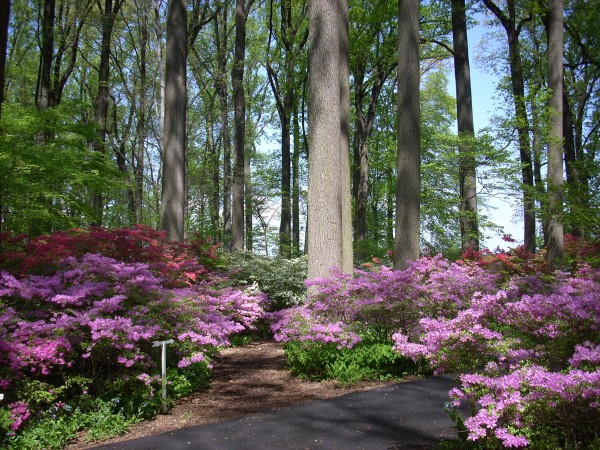False hydrangea vine 'Moonlight' 10 years of growth
on my deck.
So you want a climbing vine to cover a fence, pergola or up lattice decking. Using the vertical space in the garden is a great idea to add visual interest. There are several questions to consider first.
1.How strong is your support structure? Perennial and shrubby vines are heavy over time. If you have ever looked at the base of mature clematis, honeysuckle vine or climbing hydrangea they are woody. The weight of a heavy vine may pull down a simple lattice-work structure.
2.What is your light exposure? Most vines do well in at least 4-6 hours of sun. Without adequate sunlight, flowering is reduced.
3.Are you trying to attract pollinators, have a fragrance, or bloom in a specific season?
With those questions in mind let’s talk choices. Perennial/shrubby vines come back every year getting larger each season. Some pruning is required if they are growing larger or spreading farther than anticipated. Most do not bloom all summer.
One of my favorites is Carolina Jessamine or Gelsimium. It is an evergreen vine with bright yellow flowers. It blooms in the early spring. I am happy to see flowers in March, but for those hoping to enjoy flowers on the patio in the summer; it is not a good choice. Wisteria, is a fragrant purple beauty about this time of year, but the Asian one is a bit of a thug. Our native is better behaved- but still woody over time. Honeysuckle with its beautiful red or orange flowers is a hummingbird magnet and sweetly fragrant, but can be troubled by aphids. I have a lovely false hydrangea vine on my deck that has been there about 10 years. It has gorgeous large white flowers that attract a ton of pollinators, but with a mature height of 50 feet, it needs a severe haircut this summer after it blooms or I won’t be able to get to the washline any longer. Climbing roses are a perennial fragrant favorite, but pruning and spraying for disease are required to keep them healthy.
Vines for shade are tricky. Hydrangea vine will flower well, clematis will tolerate light shade but will flower better with at least a few hours of sun. Porcelain vine and hardy kiwi have beautiful foliage and don’t flower much to begin with but are harder to find. A quick Google search also suggested Boston Ivy. I don’t second that opinion. Removing ivy is nigh impossible and roots along the stems can bore into structures worse than just about anything else.
Vines for pollinators are much easier to suggest. One of my favorites is Mexican flame vine. It is quick growing with orange daisy-like flowers. Butterflies really like it. Mom’s favorite annual vine to attract hummingbirds is cypress vine. It is a member of the morning glory family with really fine foliage and red tubular flowers. Another great one is Spanish flag. It’s also in the morning glory family and blooms under short days, meaning that it won’t flower until late summer, but I think it’s worth it. The flowers are multicolored tubular clusters of red, yellow and orange. It’s a stunner and the hummingbirds love it. I plant it on my deck ever summer.
Moon vine blooms in the evenings to attract moths. The large white blossoms unfurl in the late afternoon and are gone by the next morning. If you use your patio or pergola a lot in the evenings, this is a great choice.
For something weird, try hyacinth bean- this quick growing vine sports pretty lavender flowers followed by long purple pods. I’m seeing it around more often as it is easy to start from seed.
Flowering vines are great way to add height and drama to a landscape, or soften a fence, but know what you are getting yourself in for.




 I can’t end this article without mentioning the edible ones. Without garden sage (Salvia officinalis)Thanksgiving stuffing would never be the same. Most common is the silvery foliage, but the purple foliage and tricolor variegated selections are also tasty. Pineapple sage (Salvia elegans)truly smells like ripe pineapples. Brew the leaves for teas, chop some for mixing with fruit salads or if you are really brave, mince some for garnish on pizza.
I can’t end this article without mentioning the edible ones. Without garden sage (Salvia officinalis)Thanksgiving stuffing would never be the same. Most common is the silvery foliage, but the purple foliage and tricolor variegated selections are also tasty. Pineapple sage (Salvia elegans)truly smells like ripe pineapples. Brew the leaves for teas, chop some for mixing with fruit salads or if you are really brave, mince some for garnish on pizza.